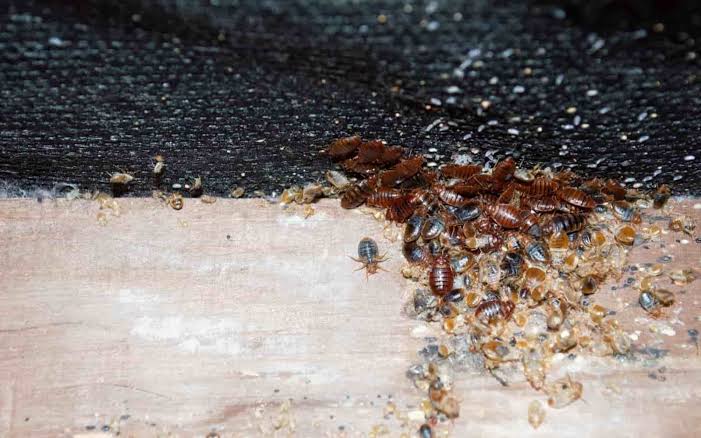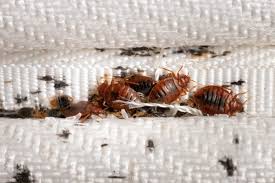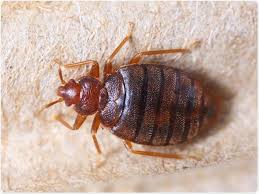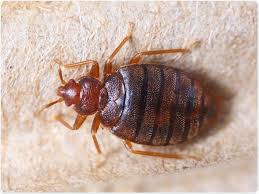Bedbugs scientifically known as Cimex lectularius are tiny insects that feed on the blood of humans and animals. These pests are flat and oval-shaped, with a reddish-brown color. Despite their small size, bedbugs can be a big problem for people, as they can infest homes and cause discomfort.
These insects are excellent hitchhikers, often latching onto clothes, luggage, or furniture to move from one place to another. This makes it easy for them to travel and spread. Bedbugs are primarily active at night, seeking out their hosts while they sleep. Their bites can result in itchy red welts on the skin, causing irritation and discomfort.
Infestations usually start in areas where people sleep or spend prolonged periods, such as bedrooms or living rooms. Bedbugs are adept at hiding in cracks, crevices, and seams of mattresses, furniture, and walls, making them challenging to detect and eliminate. Their ability to go without feeding for several months adds to the difficulty of eradicating them.
To control a bedbug infestation, thorough cleaning and regular vacuuming are essential. Additionally, sealing cracks and gaps in walls and furniture can help prevent their hiding spots. In some cases, professional pest control services may be necessary to completely eliminate these persistent insects.
It’s crucial for individuals to be vigilant and proactive in preventing bedbug infestations. Regularly inspecting and cleaning living spaces, especially bedding and furniture, can go a long way in keeping these unwelcome guests at bay. While bedbugs may not pose serious health risks, their presence can lead to stress, anxiety, and sleep disturbances, making it essential to address infestations promptly.
Dealing with bedbugs requires diligence and thoroughness. By understanding their habits and taking preventive measures, individuals can minimize the risk of infestation and maintain a comfortable living environment.
Read Also: Burmese Cat Breed (Felis catus) Description and Complete Care Guide
Animals Affected by Bedbugs (Cimex lectularius)

Bedbugs primarily feed on the blood of humans, but they can also affect various animals. Pets such as dogs and cats are susceptible to bedbug bites. These tiny pests are opportunistic and will feed on any warm-blooded creature in proximity. While they don’t typically establish infestations on animals like they do on humans, pets can become unwitting hosts.
The bites on animals may cause similar reactions as in humans, leading to skin irritation and discomfort. Pets may exhibit signs of itching, scratching, or restlessness. It’s important for pet owners to be aware of the potential presence of bedbugs, especially if they are dealing with an infestation in their home.
Livestock can also be affected by bedbugs, though such occurrences are relatively rare. Bedbugs may feed on the blood of animals like chickens and pigs, causing irritation and potential health issues. In agricultural settings, where animals are kept in close quarters, the risk of bedbug transmission between animals may increase.
Wildlife, including birds and rodents, can be hosts for bedbugs as well. These pests are adaptable and can infest nests or burrows, taking advantage of various environments to establish themselves. This adaptability allows bedbugs to survive in diverse ecosystems, although their primary association remains with human habitats.
Understanding the potential impact of bedbugs on animals emphasizes the importance of comprehensive pest control measures. While human health and comfort are the primary concerns, considering the well-being of pets and livestock is also essential in managing and preventing bedbug infestations.
Damages Caused by Bedbugs

Bedbugs, despite their small size, can cause a range of damages, both physical and psychological. The bites from bedbugs can result in red, itchy welts on the skin. While the bites themselves are not known to transmit diseases, the itching and discomfort they cause can lead to secondary infections if scratched excessively.
In addition to the physical impact, bedbugs can have significant psychological effects. Infestations often cause anxiety, stress, and sleep disturbances for individuals and families. The constant fear of being bitten during the night can lead to insomnia and a decline in mental well-being.
Beyond the direct effects on individuals, bedbugs can also harm a person’s social life. Stigma and embarrassment are common reactions to discovering a bedbug infestation, potentially leading to strained relationships and isolation.
Property damage is another consequence of bedbug infestations. These pests can hide in various cracks and crevices, making it challenging to completely eradicate them. As a result, people may discard infested furniture, bedding, and other belongings, leading to financial losses.
Moreover, the cost of professional pest control services and replacement of damaged items can strain budgets. In multi-unit dwellings, such as apartments or hotels, the risk of spreading bedbugs to neighboring units further complicates the situation, creating additional challenges for property management and residents alike.
The damages caused by bedbugs extend beyond physical discomfort. The psychological toll, potential social consequences, and financial burden of addressing infestations contribute to the overall impact on individuals and communities. Swift and thorough action is essential to mitigate these damages and restore a sense of well-being for those affected by bedbug infestations.
Read Also: Complete List of Different Types of Cat Breeds
Control and Preventive Measures

Controlling and preventing bedbug infestations requires a combination of proactive measures and thorough cleanliness. Here are some key strategies:
1. Regular Cleaning: Keep living spaces clean and clutter-free. Regularly vacuum and dust to reduce potential hiding spots for bedbugs. Pay particular attention to seams, cracks, and crevices in furniture and walls.
2. Launder Bedding: Wash bedding, curtains, and clothing regularly in hot water. High temperatures can effectively kill bedbugs and their eggs. Be sure to dry items on the hottest setting as well.
3. Seal Entry Points: Seal cracks and gaps in walls, floors, and furniture. This limits the hiding places for bedbugs and makes it more difficult for them to establish or spread infestations.
4. Use Mattress Covers: Encase mattresses and box springs with special bedbug-proof covers. This prevents bedbugs from hiding in these areas and makes it easier to spot and eliminate them.
5. Be Cautious with Second-hand Items: Inspect second-hand furniture, clothing, and other items for signs of bedbugs before bringing them into your home. Avoid acquiring used items that may carry the risk of infestation.
6. Regular Inspections: Periodically inspect living spaces for any signs of bedbugs. Early detection is crucial in preventing infestations from spreading and becoming more challenging to control.
7. Professional Pest Control: If an infestation occurs, consider hiring a licensed pest control professional. They have the expertise and tools to effectively eliminate bedbugs. DIY methods may not be sufficient for large or persistent infestations.
8. Educate Residents: In multi-unit dwellings, such as apartments, educate residents about bedbug prevention and detection. Encourage a cooperative approach to minimize the risk of infestations spreading between units.
9. Travel Precautions: When traveling, inspect hotel rooms for signs of bedbugs. Keep luggage off the floor and away from beds. Upon returning home, carefully inspect and clean luggage before bringing it inside.
10. Timely Action: Address any signs of bedbug infestations promptly. Delaying action can allow these pests to multiply and spread, making control more challenging.
By incorporating these measures into a regular routine, individuals can significantly reduce the risk of bedbug infestations and maintain a healthier living environment. Prevention and early intervention are key components in effective bedbug management.
Frequently Asked Questions (FAQs) About Bedbugs (Cimex lectularius)
Q1: What are bedbugs?
A1: Bedbugs are small, reddish-brown insects that feed on the blood of humans and animals. They are nocturnal and often hide in cracks and crevices during the day.
Q2: How do bedbugs enter homes?
A2: Bedbugs can enter homes through infested furniture, luggage, or clothing. They are excellent hitchhikers and can be transported unknowingly.
Q3: What are the signs of a bedbug infestation?
A3: Signs include itchy bites, small reddish-brown bugs on bedding or furniture, and tiny bloodstains on sheets. Shed skins and a sweet, musty odor may also indicate an infestation.
Q4: Do bedbugs transmit diseases?
A4: While bedbug bites can cause itching and discomfort, they are not known to transmit diseases to humans.
Q5: Can bedbugs infest pets?
A5: Yes, bedbugs can bite pets, but they don’t typically establish infestations on them. Pets may show signs of itching and restlessness if bitten.
Q6: How can I prevent bedbug infestations?
A6: Regular cleaning, sealing entry points, using mattress covers, and being cautious with second-hand items can help prevent bedbug infestations. Additionally, practicing good hygiene and inspecting for signs regularly are crucial.
Q7: What should I do if I suspect a bedbug infestation?
A7: Act promptly. Launder bedding, vacuum thoroughly, and consider hiring a professional pest control service for effective eradication.
Q8: Can I get rid of bedbugs on my own?
A8: While some DIY methods may help, professional pest control is often necessary for complete eradication, especially in larger or persistent infestations.
Q9: How long can bedbugs survive without feeding?
A9: Bedbugs can survive several months without a blood meal, making them resilient and challenging to eliminate.
Q10: Are bedbugs only found in beds?
A10: No, bedbugs can hide in various places, including furniture, cracks in walls, and even electrical outlets. They are adaptable and can infest different parts of a living space.
Read Also: Best Organic Fertilizer for Vegetables

